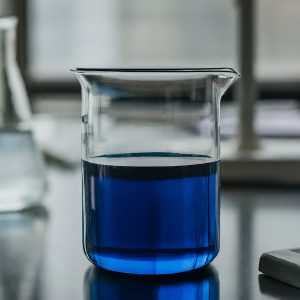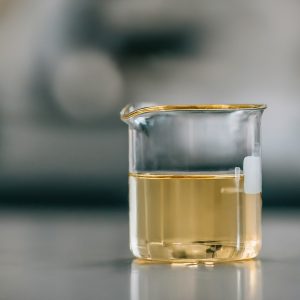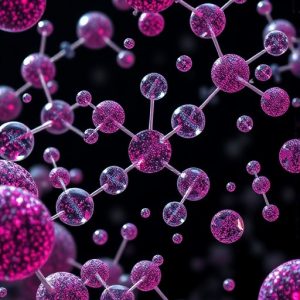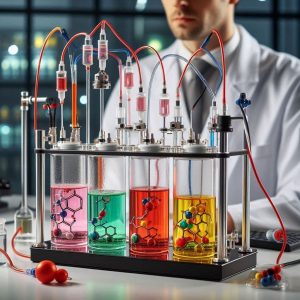Aqueous Vanadium Solutions Catalysts for a Sustainable Future
Aqueous Vanadium Solutions such as that of vanadium sulfate, sodium vanadate, potassium metavanadate, and vanadium oxalate, are playing a transformative role in the future of technology and energy. These versatile aqueous vanadium solutions are at the forefront of emerging applications in next-generation energy storage systems, advanced catalysis, and cutting-edge material science. With the global shift towards renewable energy and the need for more efficient industrial processes, vanadium solutions for VRFBs offer promising pathways to enhanced performance and reduced environmental impact. Looking ahead, their potential to drive breakthroughs in areas like grid-scale energy storage, green chemistry, and high-performance materials positions vanadium solutions as key enablers of a more sustainable and technologically advanced future.
Sodium Vanadate Solution A Versatile Catalyst
 Sodium vanadate solution is a widely used in a research and industry process. Its principal domain is as a potent inhibitor in enzymatic activities, specifically in the field of biochemistry. Sodium vanadate solution is a highly effective agent for converting hydrogen sulfide (H₂S) gas into elemental sulfur (S), making it invaluable in processes like the Stretford and Benfield methods for gas purification. This solution excels in removing both H₂S and carbon dioxide (CO₂) from gases, ensuring cleaner emissions. Compared to sodium ammonium metavanadate, sodium vanadate boasts a higher vanadium content, enhancing its catalytic efficiency. Additionally, it features low chloride content and is ammonia-free, making it a superior choice for various industrial applications.
Sodium vanadate solution is a widely used in a research and industry process. Its principal domain is as a potent inhibitor in enzymatic activities, specifically in the field of biochemistry. Sodium vanadate solution is a highly effective agent for converting hydrogen sulfide (H₂S) gas into elemental sulfur (S), making it invaluable in processes like the Stretford and Benfield methods for gas purification. This solution excels in removing both H₂S and carbon dioxide (CO₂) from gases, ensuring cleaner emissions. Compared to sodium ammonium metavanadate, sodium vanadate boasts a higher vanadium content, enhancing its catalytic efficiency. Additionally, it features low chloride content and is ammonia-free, making it a superior choice for various industrial applications.
| Specifications of Sodium Vanadate Solution | |
| Appearance | Straw-green coloured liquid |
| Specific Gravity | 1.20-1.25 g/cc |
| Bulk density | 1.198-1.258 kg/L |
This combination of properties makes sodium vanadate solution a versatile and efficient catalyst in industrial gas purification processes
High Vanadium Content: Sodium vanadate has a higher vanadium content compared to alternatives like sodium ammonium metavanadate. This enhances its catalytic efficiency, making it more effective in gas purification using seamless SS tubes and pipes.
Low Chloride Content: The low chloride content in sodium vanadate solution reduces the risk of corrosion in industrial equipment, thereby extending the lifespan of the machinery used in gas purification processes.
Ammonia-Free: Being ammonia-free, sodium vanadate solution is safer to handle and reduces the environmental impact associated with ammonia emissions.
Effective H₂S (hydrogen sulfide) Conversion: In the Stretford process, sodium vanadate solution catalytically oxidizes H₂S to elemental sulfur, ensuring efficient removal of this toxic gas from industrial emissions.
Versatility: Its ability to function effectively in various gas purification processes, including the Benfield process, highlights its versatility. In the Benfield process, it aids in the absorption and removal of CO₂ and H₂S from gas streams.
Industry Applications of Sodium Vanadate Solution
Corrosion Inhibition: Sodium vanadate is used as a corrosion inhibitor in various industries, including aerospace and marine applications, where it helps protect metals from oxidation. Example: Research is ongoing into sodium vanadate-based coatings that can extend the life of aluminum and steel components in harsh environments.
Pigments and Dyes: Sodium vanadate is used in the production of inorganic pigments, providing unique colours for ceramics and glass applications.
Catalysis: It also finds applications in catalysis, especially in the oxidation of ammonia in the production of nitric acid.
Vanadium Sulfate Solution: A Key Catalyst in Sulfur Removal
 Vanadium sulfate solution plays a crucial role in the catalytic removal of sulfur during oil refining and other industrial processes. This dark blue, viscous liquid is highly effective in breaking down sulfur compounds, ensuring cleaner and more efficient refining operations. Its high specific gravity and bulk density make it a robust and reliable catalyst, capable of withstanding the demanding conditions of industrial applications. By facilitating the removal of sulfur, vanadium sulfate solution helps in producing cleaner fuels and reducing harmful emissions, contributing to a more sustainable and environmentally friendly refining process.
Vanadium sulfate solution plays a crucial role in the catalytic removal of sulfur during oil refining and other industrial processes. This dark blue, viscous liquid is highly effective in breaking down sulfur compounds, ensuring cleaner and more efficient refining operations. Its high specific gravity and bulk density make it a robust and reliable catalyst, capable of withstanding the demanding conditions of industrial applications. By facilitating the removal of sulfur, vanadium sulfate solution helps in producing cleaner fuels and reducing harmful emissions, contributing to a more sustainable and environmentally friendly refining process.
| Specifications of Vanadium Sulfate Solution | |
| Appearance | Dark blue viscous liquid |
| Specific Gravity | 1.38-1.47 g/cc |
| Bulk Density | 1.35-1.47 kg/L |
This combination of properties underscores the importance of vanadium sulfate solution in modern industrial practices, highlighting its role in promoting cleaner and more efficient sulfur removal.
High Efficiency: Vanadium sulfate solution enhances the efficiency of sulfur removal processes, making it an indispensable component in oil refining.
Environmental Impact: By reducing sulfur content in fuels, it helps lower the emission of sulfur oxides, which are harmful pollutants.
Robust Performance: Its specific gravity and bulk density ensure that it performs reliably under the demanding conditions of industrial applications.
Industry Applications of Vanadium sulfate solution
Energy Storage (Redox Flow Batteries): Vanadium sulfate is used in vanadium redox flow batteries (VRFBs), which are a type of rechargeable flow battery. VRFBs are being developed for large-scale energy storage solutions due to their ability to provide long-duration energy storage with a high cycle life. Example: Companies like Invinity Energy Systems and Sumitomo Electric are exploring VRFBs for grid-scale storage, utilizing vanadium sulfate in their electrolyte formulations.
Catalysts: Vanadium sulfate is used as a catalyst in the production of sulfuric acid and in various organic synthesis processes, particularly in the oxidation of hydrocarbons.
Potassium Metavanadate Solution: A Reliable Corrosion Inhibitor
 Potassium metavanadate solution is a crucial component in the Stretford and Benfield processes, serving as an effective corrosion inhibitor. This light straw-coloured liquid helps protect industrial equipment from the corrosive effects of gases and chemicals involved in gas purification. By preventing corrosion, potassium metavanadate solution extends the lifespan of machinery and ensures the efficiency and safety of the purification processes. Its specific gravity and bulk density make it a robust and reliable choice for industrial applications, highlighting its importance in maintaining the integrity of gas purification systems.
Potassium metavanadate solution is a crucial component in the Stretford and Benfield processes, serving as an effective corrosion inhibitor. This light straw-coloured liquid helps protect industrial equipment from the corrosive effects of gases and chemicals involved in gas purification. By preventing corrosion, potassium metavanadate solution extends the lifespan of machinery and ensures the efficiency and safety of the purification processes. Its specific gravity and bulk density make it a robust and reliable choice for industrial applications, highlighting its importance in maintaining the integrity of gas purification systems.
| Specifications of Potassium Metavanadate Solution | |
| Appearance | Light straw-coloured liquid |
| Specific Gravity | 1.42-1.55 g/cc |
| Bulk Density | 1.294-1.546 kg/L |
This combination of properties underscores the effectiveness of potassium metavanadate solution as a corrosion inhibitor, making it an essential component in the Stretford and Benfield processes.
Corrosion Protection: It provides robust protection against corrosion, safeguarding equipment and reducing maintenance costs.
Efficiency: Enhances the overall efficiency of the Stretford and Benfield processes by maintaining the integrity of the equipment.
Reliability: Its specific gravity and bulk density make it a reliable choice for industrial applications, ensuring consistent performance.
Industry Applications of Potassium metavanadate solution
Glass Manufacturing: Potassium metavanadate is used in the glass industry as a colorant and to improve the UV-absorption properties of glass. Example: Specialized glass products, such as those used in radiation shielding or in high-performance optics, incorporate potassium metavanadate to enhance their properties.
Catalyst in Organic Synthesis: It is used as a catalyst in organic chemistry, particularly in oxidation reactions.
Water Treatment: Potassium metavanadate is being explored for its potential in water treatment processes, particularly in the removal of pollutants through catalytic oxidation.
Vanadium Oxalate Solution: A Catalyst for Sulfur and Nitrogen Removal
 Vanadium oxalate solution is a powerful catalyst used in the refining of oil, specifically for the removal of sulfur and nitrogen compounds. This dark blue aqueous liquid is highly effective in breaking down these impurities, ensuring cleaner and more efficient refining processes. It is a robust and reliable catalyst for enhancing the quality of refined oil.
Vanadium oxalate solution is a powerful catalyst used in the refining of oil, specifically for the removal of sulfur and nitrogen compounds. This dark blue aqueous liquid is highly effective in breaking down these impurities, ensuring cleaner and more efficient refining processes. It is a robust and reliable catalyst for enhancing the quality of refined oil.
Industrial Applications of Vanadium Oxalate Solution
Catalysis and Material Science: Vanadium oxalate solution enhances the removal of sulfur and nitrogen, improving the quality of refined oil.
It is also used in the synthesis of vanadium-containing catalysts and materials, which are applied in various chemical processes, including polymerization and oxidation reactions.
Nanomaterials Synthesis: Vanadium oxalate is used as a precursor in the synthesis of vanadium-based nanomaterials like VO2 which have various uses.
Specifications:
| No. | Tests | Specifications |
| 1 | Description | Blue aqueous liquid |
| 2 | Density (g/ml) | 1.15 to 1.17 |
| 3 | pH | 0.9 to 2.1 |
| 4 | Vanadium Content as V (%w/v) | 5.5 to 6.5 |
| 5 | Vanadium Pentoxide Content (as V2O5) (%w/v) | 9.82 to 11.60 |
As we move further into a future defined by the need for cleaner energy, more efficient industrial processes, and advanced materials, the role of vanadium solutions will only become more critical. Their applications in diverse fields from energy storage to catalysis highlight their versatility and importance in driving technological innovation. By embracing the potential of vanadium solutions, industries can not only improve their operational efficiencies but also contribute to a more sustainable and environmentally conscious world. As research and development continue to expand the horizons of what these compounds can achieve, vanadium solutions are set to become indispensable in shaping the future of industrial and technological progress.














